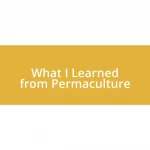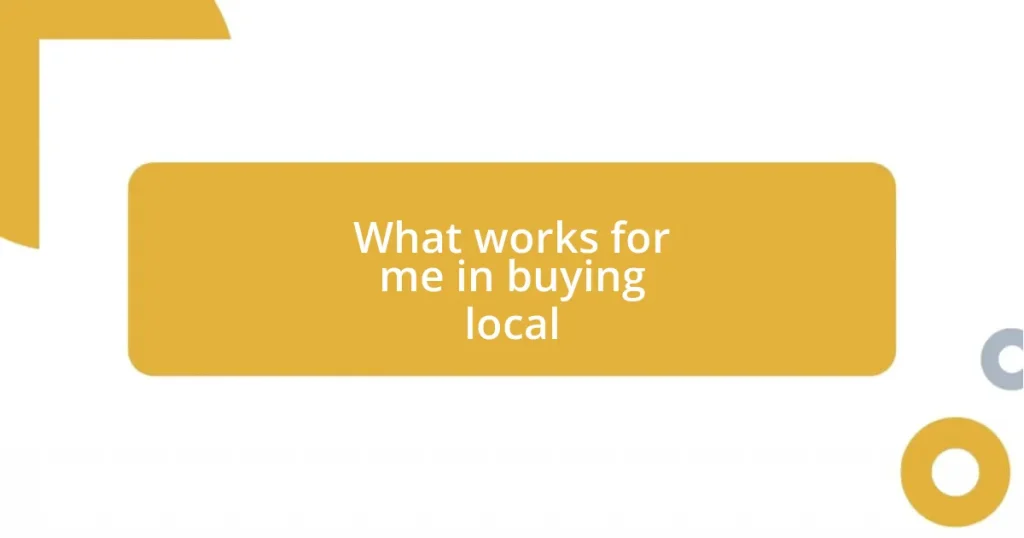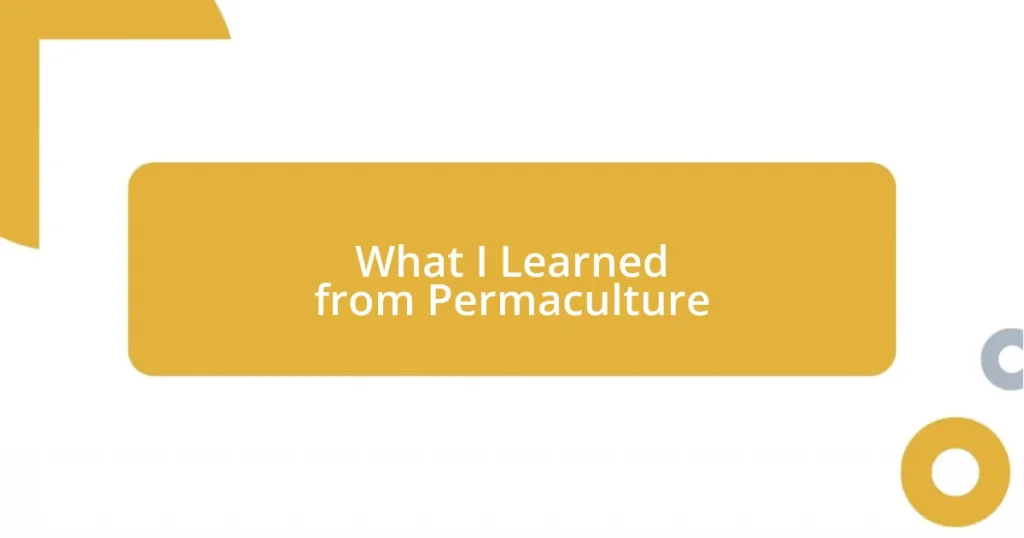Key takeaways:
- Buying local fosters a sense of community and belonging, enhancing personal relationships with vendors and producers.
- Local purchases support the economy by circulating money within the community and encouraging local growth.
- Quality and freshness of local products often surpass mass-produced alternatives, providing unique and authentic experiences.
- Building relationships with local sellers can lead to exclusive insights, offers, and a deeper appreciation for the products purchased.

Understanding local buying benefits
Buying local connects us not only to our community but also to a sense of belonging. I’ll never forget my first visit to a local farmers’ market; the warmth of the vendors and the vibrant colors of fresh produce created a nurturing atmosphere. Can you recall how you felt discovering that perfect loaf of bread made just a few blocks away? That personal relationship with local producers adds depth to the buying experience.
Supporting local businesses also boosts the local economy in tangible ways. I’ve noticed that my favorite cafe often sources its ingredients from nearby farms, creating a ripple effect that strengthens our community. When I spend money here, I see it as contributing directly to my neighborhood’s vibrancy. Have you ever paused to consider how your dollar circulates through the local economy, keeping it alive and thriving?
Moreover, buying locally often means higher quality and freshness. Whenever I choose local goods, I feel confident that I’m getting the best. One time, I bought a jar of local honey that tasted like sunshine—pure and unfiltered. When have you experienced that exquisite pleasure of tasting something truly fresh and authentic? That’s the kind of experience that mass-produced items just can’t replicate.
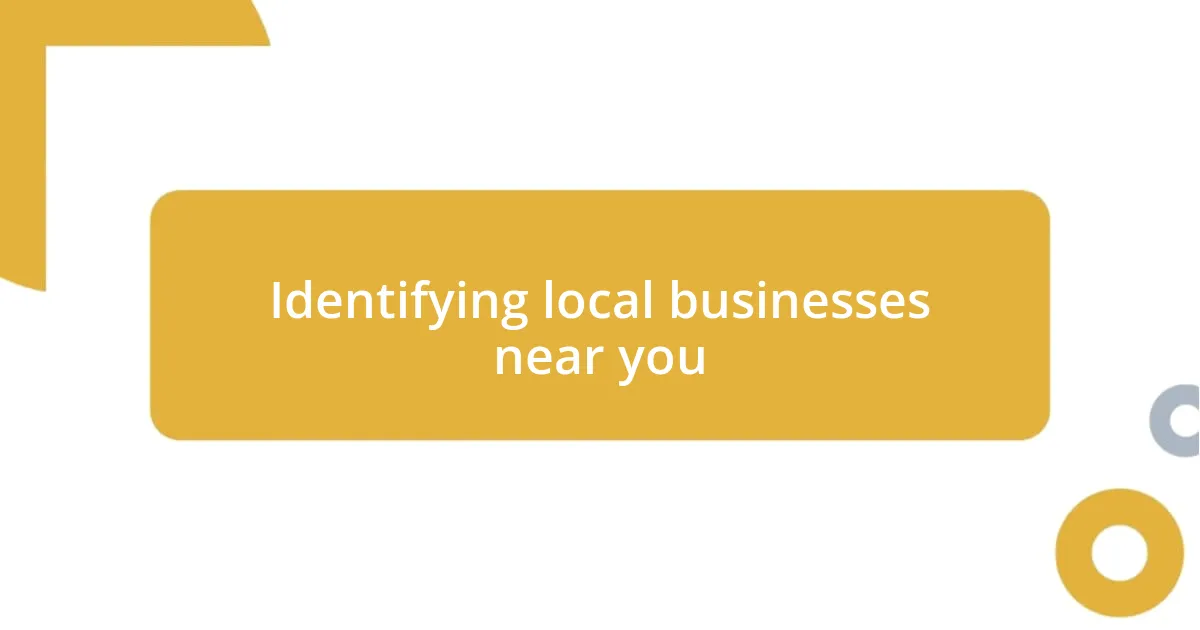
Identifying local businesses near you
Identifying local businesses can be an enjoyable adventure. I often start by exploring my neighborhood on foot. It’s surprising how many hidden gems you can discover just by wandering the streets. Local shops, cafes, and craft stores often reflect the unique character of their surroundings. Have you ever stumbled upon a quaint bookstore with comfy reading nooks while taking a casual stroll? Those delightful surprises can make a day feel special.
Online searches are another effective tool. I’ve found that using local business directories or social media platforms can unveil more options than I initially thought. Just last week, I came across a small artisan jewelry maker through Instagram who I now adore. The bonus? These platforms often showcase customer reviews which help me gauge the quality and service. Has online exploration ever led you to a favorite local spot that you wish you had known about sooner?
Don’t underestimate the power of community recommendations. Friends, family, or even neighbors might have a go-to local favorite that I haven’t tried yet. There’s something heartwarming about sharing recommendations over a cup of coffee with friends. Recently, I visited a local bakery recommended by a neighbor, and it turned out to be my new go-to for fresh pastries. There’s a connection created within our local networks that brings us closer together.
| Method | Description |
|---|---|
| Exploring on foot | Discovering local businesses by wandering the streets and enjoying the surroundings. |
| Online searches | Utilizing directories and social media to find and learn about local options. |
| Community recommendations | Gathering suggestions from friends and family to uncover hidden local gems. |

Evaluating product quality locally
Evaluating product quality when buying local is an essential step in ensuring that what you purchase meets your standards. I remember the first time I carefully inspected a bunch of locally-grown tomatoes at the farmers’ market. Their vibrant color and firm texture spoke volumes about their quality. There’s something strangely satisfying about knowing that the food on my table is grown just down the road, especially when it shines with freshness that grocery store produce rarely offers.
To help you assess quality, consider the following factors:
- Appearance: Is the product vibrant and free from blemishes?
- Smell: Fresh items often have a rich, inviting aroma that appeals to the senses.
- Texture: Can you feel the ripeness? Texture can offer clues to freshness.
- Source: Knowing where a product comes from—like a local farm or artisan—can give you confidence in its quality.
- Taste: Don’t hesitate to ask for samples; a quick taste test can reveal a great deal about the product.
These insights can transform local shopping from a simple transaction into a rewarding experience that nourishes both body and spirit. I find that engaging with vendors, asking about their farming or production practices, offers a deeper understanding and appreciation of the products I choose to bring home. It’s like having a mini-conversation about their passion, which invariably makes me cherish the product even more.

Comparing prices in local markets
When I set foot in a local market, the first thing I do is scan the various stalls and compare prices. It’s fascinating how price fluctuation can often reflect the story behind each vendor. Recently, while at the farmer’s market, I noticed that one vendor’s organic strawberries were significantly pricier than another’s. Out of curiosity, I asked why, and learned that the pricier batch was picked that morning and sourced from nearby, whereas the other came from a larger wholesaler. It was a good reminder that sometimes, you pay for freshness and quality, and those conversations can guide my choices.
Another aspect I cherish is the opportunity to negotiate a bit, especially when buying in bulk. I remember purchasing several jars of homemade jam from a local stall. I decided to ask if there was any discount for buying three instead of one. To my surprise, the vendor smiled and offered a small price reduction. This experience reinforced how a friendly conversation could not only save me a few bucks but also create a connection with the seller. Have you found that engaging with local vendors often leads to unexpected deals?
Finally, I’ve noticed that local markets sometimes have loyalty programs or special deals for repeat customers. One time, while picking up fresh herbs at a small family-owned shop, the owner casually mentioned a “buy ten, get one free” deal for frequent buyers. That little excitement for our shared enthusiasm for the herbs added a special touch to my shopping experience. It’s these moments of personal recognition that make me feel valued as a customer and encourage me to return again and again. Isn’t it amazing how local shopping can lead to more than just transactions?

Building relationships with local sellers
There’s a unique joy I find in building relationships with local sellers. One Saturday, while picking up some artisanal bread at a quaint bakery, the owner and I struck up a conversation about his baking techniques. As I shared my own attempts at homemade bread, he laughed and offered me tips—giving me not just a loaf but a shared experience. Moments like these remind me that local shopping isn’t just about the product; it’s about the community and the connections we create.
I’ve also realized that these relationships can lead to exclusive offers and knowledge that you simply can’t get at larger stores. For instance, a local florist once informed me about a rare bloom arriving the following week, just because she knew I loved gardening. Imagine the thrill of being in the loop! How often do you get that personal touch in a big retail chain? It’s these insider insights that enrich my buying experience far beyond mere convenience.
Each time I visit a local seller, I’m reminded of the stories behind the products. When I buy honey from a nearby apiary, the beekeeper always shares tales of his bees and their busy lives. This storytelling adds depth to my purchase, making each jar special. By fostering these relationships, I feel like I’m part of a larger narrative—that my choices support local artisans and contribute to the vibrancy of my community. Doesn’t that make you reconsider where you shop?
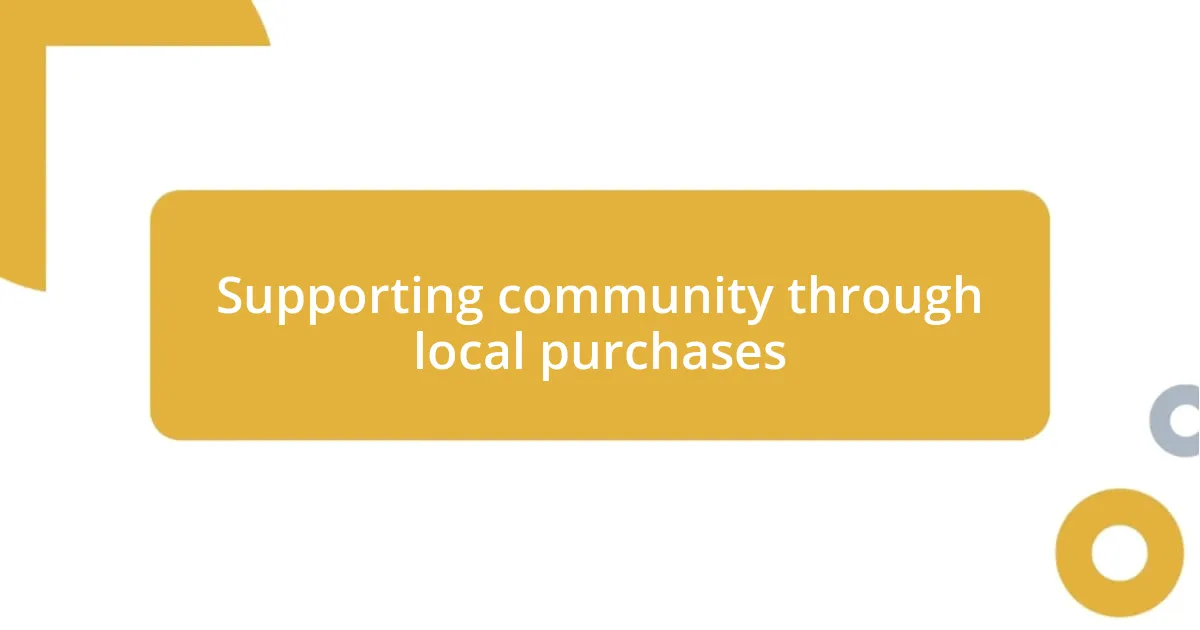
Supporting community through local purchases

One of the most beautiful aspects of supporting local businesses is the community spirit that comes with it. I vividly recall attending a block party organized by a group of local shops. As I meandered through the stalls, I felt an overwhelming sense of belonging—neighbors and shop owners mingled, sharing laughter and stories. Have you ever had that moment when you realize that shopping local goes beyond mere transactions? It’s all about celebrating our shared experiences and building a support network.
Additionally, buying local truly helps strengthen the community. I remember when our local bookshop hosted a reading event with a local author. Not only did I discover a new favorite book, but I also met fellow readers who shared my interests. That kind of connection makes you feel like part of something bigger, doesn’t it? Every dollar I spent that night helped keep the shop alive, allowing it to continue nurturing creativity in our town.
Beyond that, every purchase feels like an investment in my community’s future. Each time I choose a handmade scarf from a local craftsman, I’m not merely acquiring an item; I’m supporting a passion, a dream, and the local economy, too. I think about all the families sustained by these small businesses, and it prompts me to choose local whenever possible. Isn’t it inspiring to know that my simple acts of shopping can contribute to a thriving community?


